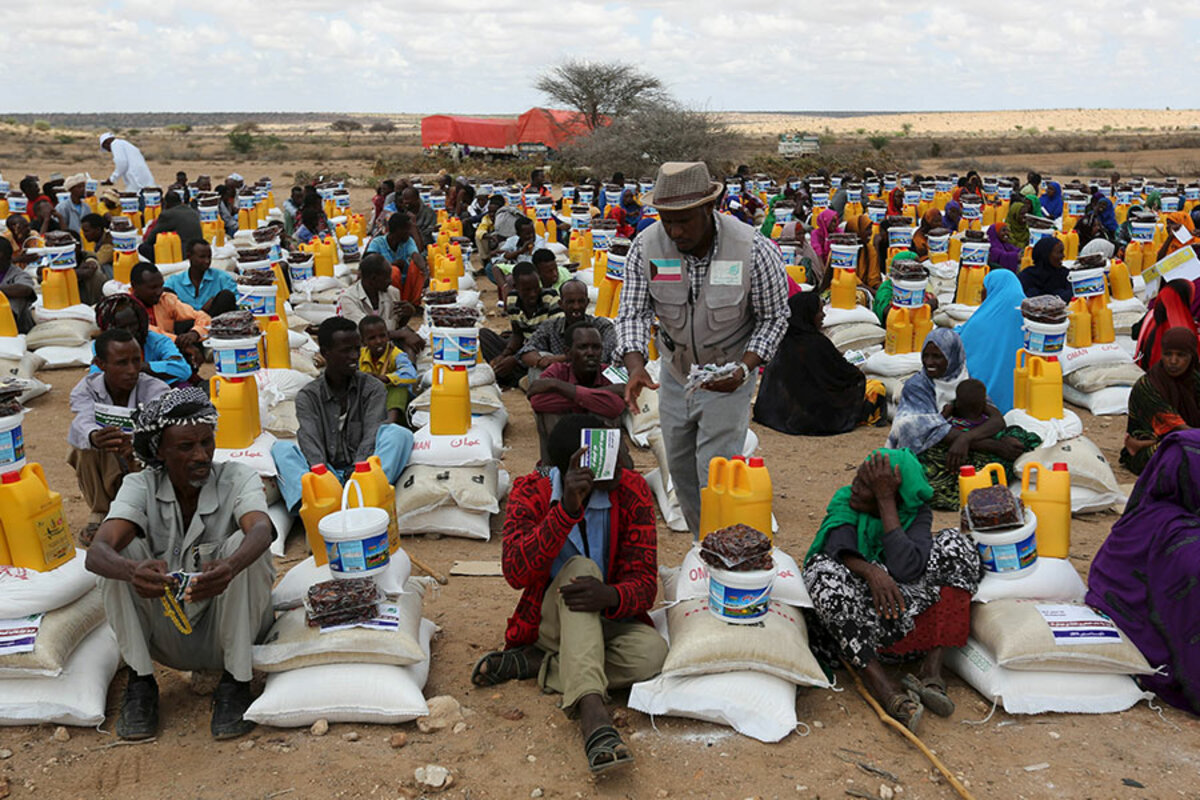The humanitarian revolution: What happens when emergencies don't end?
Loading...
| United Nations, N.Y.
When Gordon Brown unveiled a new fund for educating children displaced by conflict and disaster, the former British prime minister was admittedly trying to shake the world of global aid by the lapels.
He described the initiative this week as “the first to bridge the gap between humanitarian aid and development aid.”
The Education Cannot Wait fund is perhaps the boldest statement to date of a growing conviction within the global aid community – that the separation between life-saving humanitarian intervention and life-enhancing development assistance makes less and less sense.
Traditionally, the two have been different, with emergency intervention focused on acute crises and development assistance dealing with chronic problems.
But as conflicts stretch longer and climate-related disasters intensify, more people are being displaced longer, and humanitarian crises are evolving into development setbacks.
The 30 million children displaced by conflict and natural disasters will remain away from their homes for a decade or more, noted Mr. Brown, now a United Nations education envoy. Previously, they might have been seen mostly as a cause for immediate humanitarian aid. But unless the schoolhouse door is opened to them now – bringing development assistance to bear – the world risks creating a “lost generation,” he added.
Brown will formally launch the effort Monday at the World Humanitarian Summit in Istanbul, Turkey, which the UN has called to address what Secretary-General Ban Ki-moon calls a mounting humanitarian crisis. The subject of bringing humanitarian and development work closer together is expected to be a major theme.
“In many ways the lines are blurring between humanitarian assistance and development aid, but I think the lesson needs to be that we need both,” says Glenn Denning, a professor of development policy at Columbia University in New York. “It may sound obvious, but it’s just not smart to focus on one and not the other – particularly today.”
• • •
In many ways, the shift is the result of realities that have already taken hold on the ground.
For United States disaster response, missions have in many cases grown longer because the humanitarian crises have made existing development shortcomings worse, notes Carla Koppell, vice president for applied conflict resolution at the US Institute of Peace in Washington.
“It used to be that a USAID DART [Disaster Assistance Response Team] assumed six months on the ground for getting a job done,” says Ms. Koppell, a former chief strategy officer at the United States Agency for International Development (USAID). “Those teams are in there now for years in some cases.”
“We’re seeing a shift both in terms of the longevity of humanitarian crises and, as a result of that, a growing overlap with folks who come in post-emergency to work on the durable gains of the development side,” she adds.
The extended conflicts in Syria, Afghanistan, Iraq, and parts of Africa are driving much of the rethink. For instance, if school-aged children uprooted by war have to wait for those wars to end to go to school, they risk being robbed of any education, as the UN’s Brown noted.
The new education fund aims to offer up to five years of emergency education to displaced children – not just weeks or months, as is now often the case.
But multiplying and intensifying climate-related disasters are also playing a role. Armed conflicts may grab global attention, but climate change is displacing tens of thousands of people every day and increasing instability that can lead to conflict, UN officials say.
“The demand for emergency assistance far outstrips supply,” says Josefina Stubbs, associate vice president and chief strategist at the UN’s International Fund for Agricultural Development. “We cannot keep jumping from crisis to crisis. We have to invest in long-term development that helps people cope with shocks so that they can continue to grow enough food for their communities and not require emergency aid.”
Melding humanitarian and development work in this way has other crucial benefits, too, Ms. Stubbs says. Humanitarian efforts simply don’t have enough money.
Between 2008 and 2015, global humanitarian appeals have more than doubled to $18.7 billion, according to the UN’s Office for the Coordination of Humanitarian Affairs. But only just over half of that appeal was met; prospects for this year’s unprecedented $20 billion request are not brighter.
One way to reduce humanitarian needs, Stubbs and others say, is to focus more on development so that natural disasters don’t automatically mean costly humanitarian crises.
Ethiopia offers a case in point: The country had no safety net structure when drought struck in the mid-1980s, and it turned to famine. More than 1 million people died.
Now drought has struck again, but a social safety net has helped prevent the crop failure and malnutrition from deteriorating further into a full-blown humanitarian calamity.
Another example is the “build back better” movement, which places a premium on rebuilding communities devastated by disasters with more sustainable, sturdier, and better-located housing and infrastructure, notes Koppell of the US Institute of Peace.
• • •
But the talk of lowering the walls between humanitarian assistance and development programs has advocates on both sides nervous.
The medical humanitarian organization Doctors Without Borders abruptly pulled out of next week’s summit, saying in part that it feared the global gathering would short-change emergency intervention by favoring a shift to development priorities.
“We no longer have any hope that the [summit] will address the weaknesses in humanitarian action and emergency response,” the group said in a statement last week. “Instead, the [summit] focus would seem to be an incorporation of humanitarian assistance into a broader development and resilience agenda.”
Moreover, many development experts worry that less distinction would mean that slow-and-steady development programs would lose out to the emotional appeal of humanitarian crises.
“What concerns a lot of people is that the humanitarian side becomes the focus at the expense of development because it tugs at us as human beings, it’s in our face, it’s on TV,” says Professor Denning of Columbia. “People respond to that better than to long-term needs, even if it’s the long-term investments that ultimately prevent some of these recurring crises.”
The two efforts certainly can have different needs, but that only shows why both are necessary, says Koppell. She imagines the delivery of gas-fired electrical generators to a disaster area as a case in point.
“The humanitarian relief worker will see those generators as life-savers as they fire up to deliver the electricity to power emergency clinics and maybe water-purification systems,” she says. “But the development worker will look at the long-term effect of those generators, think of the impact on the local environment and on climate change, and focus on ways to improve conditions so that those generators might never be needed again.”
The need going forward, she says, is to find an appropriate balance.
“There is no difference in the ambitions of the two communities – for both it’s serving people in need,” Koppell says. “It will take time, but I think the relief and development workers are close enough that even under the strain of these extended crises they’ll figure out a way to work together toward that common ambition.”
[Editor's note: The spelling of Carla Koppell's name has been corrected.]
The humanitarian revolution
Part 1: Reimagining a colonial-era model
Part 2: Ensuring the 'dignity' of a job
Part 3: What happens when emergencies don't end?
Part 4: At UN summit, a new 'hope'






